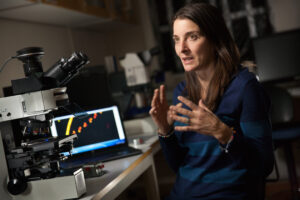
- This event has passed.
MEAS Department Seminar
April 19, 2021 | 3:30 pm - 4:30 pm
Speaker– Rachel Foster, Stockholm University (hosted by R. Paerl)
Seminar Title– It takes two to tango in the open sea: the ecology and activity of diatom-diazotroph symbioses
Bio – After earning a B.S. in Biology with a focus on Marine and Freshwater Biology from the University of New Hampshire, USA, Dr. Rachel A. Foster spent several years exploring the California coast prior to volunteering on her first oceanographic research cruise to the Western Tropical North Atlantic. It was an experience that set her on track to applying and continuing her studies in Marine Science. She later received a MSc in Marine and Environmental Biology (1996-2000) and a PhD in Coastal Oceanography (2000-2004) from Stony Brook University, USA.
After her PhD work, Dr. Foster spent several years as a postdoctoral researcher at the University of California, Santa Cruz (UCSC; 2004-2010) working on microbial ecology of diazotrophic cyanobacteria. In 2010, Dr. Foster joined the Biogeochemistry Department of the Max Planck Institute for Marine Microbiology in Bremen, Germany as a Lead Scientist and the facility manager for the nanoSIMS 50L. In 2013, Foster was sponsored by the Department of Ecology, Environment and Plant Sciences of Stockholm University and later selected as a Wallenberg Academy Fellow to lead research on planktonic symbioses.
Dr. Foster’s research focuses on the distribution, activity and diversity of marine phytoplankton and their overall roles in biogeochemical cycles and ecosystem function. To study the in situ activity and interactions (i.e. nutrient exchanges) between marine microorganisms Foster’s lab uses combinations of microscopic techniques with targeted molecular biological and isotope tracer assays.
Abstract – Some of the most enigmatic components of the plankton are the microalgal groups, which carry intimately associated cyanobacteria as symbionts. In the sunlit zone of the aquatic ecosystems where dissolved nutrients are largely limiting, cyanobacteria pair up with a diverse group of eukaryotes. In some planktonic symbioses with diatoms, the cyanobacterial partners are either heterocyst-forming and in two genera, including a freshwater family of diatoms, the cyanobacteria are unicellular. In all, the cyanobacteria are N 2 -fixers, and thus function as a nitrogen (N) source for their respective hosts. The diatom symbioses are broadly distributed in the world’s oceans, and contribute to global N and carbon(C) cycles due to high fixation and sinking rates. Despite their ubiquitous distribution and biogeochemical significance, our understanding of the intimate nature between the partners remains understudied.
Recently we identified a continuum of symbiont integration in the symbioses, where the symbiont cellular location is tightly coupled to genome size, content, transporter number, and the timing of the partnerships. Time-calibrated trees dated the appearance from 100-50 Mya and was consistent with the symbiont cellular location: recently evolved symbionts are externally located. Internal symbionts have fewer transporters for N substrates, and several C transporters appear to be incomplete, or missing. There is a size and light dependent relationship where larger diatom hosts team up with larger symbionts, and this is also reflected in higher N 2 and C fixation. The distribution and abundance for the three main diatom-cyanobacteria symbioses were mapped and quantified by an image recognition model and genes specific for the symbionts in the global Tara datasets. Results identified several new locations, and insights into the ecology of these hard to study symbioses. Combining several methodologies new intriguing aspects for these planktonic partnerships have been revealed and will be presented.
Please check your email for a Zoom link.